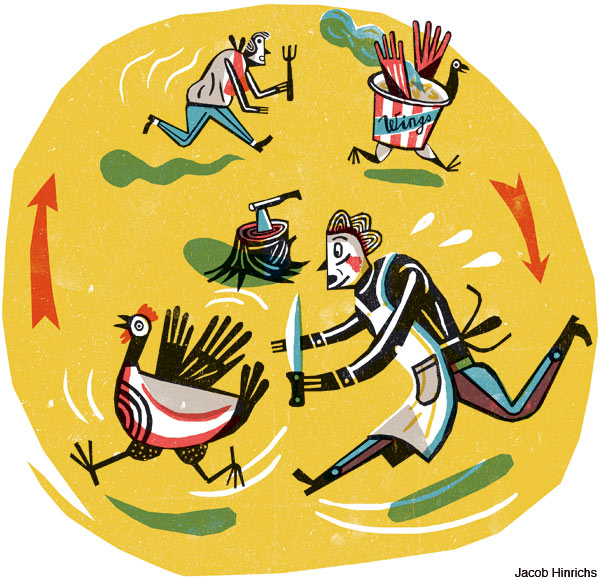How to Kill a Chicken

“You’re aiming for right in front of the backbone, at the back of the neck, and then it’s just a small cut forward,” John Hopkins tells me, gesturing with deft hands coated in chicken blood. Such is life (and death) on Orangeville’s Forks Farm, where Hopkins and his wife, Todd, raise about 3,000 chickens a year—one of which I’m clumsily knifing in the neck.
“I’m sorry, I’m sorry,” I whisper to the squawking bird as I struggle, until—suddenly—the knife goes smoothly in. There’s a gush of blood, and it’s over. I don’t notice the specks of congealed red on my face and arms and sweater until one of the other poultry-processors laughs and points out the gore.
“When we first started this, everyone thought we were crazy,” John told me during our 7 a.m. chicken-catching lesson. (“Grab around the wings … gentle but firm.”) I can relate: It wasn’t easy explaining to friends my desire to learn to kill poultry. It was about being a responsible carnivore, I told them—a way to try and close a little of that distance between my food and myself. I wanted to experience the full cycle of life to death to dining, at least once.
I also wanted to do it right, which is why I chose Forks Farm, 144 miles northwest of Philly. John and Todd bought the place back in 1986, before “organic” and “sustainable” became buzzwords. They focused on pastured poultry—grass-raised birds, housed in large covered pens that are moved daily and processed by hand in simple open-air facilities. The method stands in stark opposition—both in scale and ideology—to the giant, mechanized chicken farms that dominate the industry.
As I stand in the crisp air, it does feel right, somehow, watching the sun rise and cutting the heads and feet off dead birds. It’s satisfying when I find the locations of the gizzard, intestines, heart; when I learn that chicken innards can be composted; and when, by bird three, I get the motions down and my chicken dies gently, without a sputter. I take out the innards myself and bring the whole thing home to freeze. I’ll thaw it out, one of these cold January nights, and roast it with garlic and rosemary potatoes.
Forks Farm Summer Markets are June through October, second and fourth Saturdays of the month.


